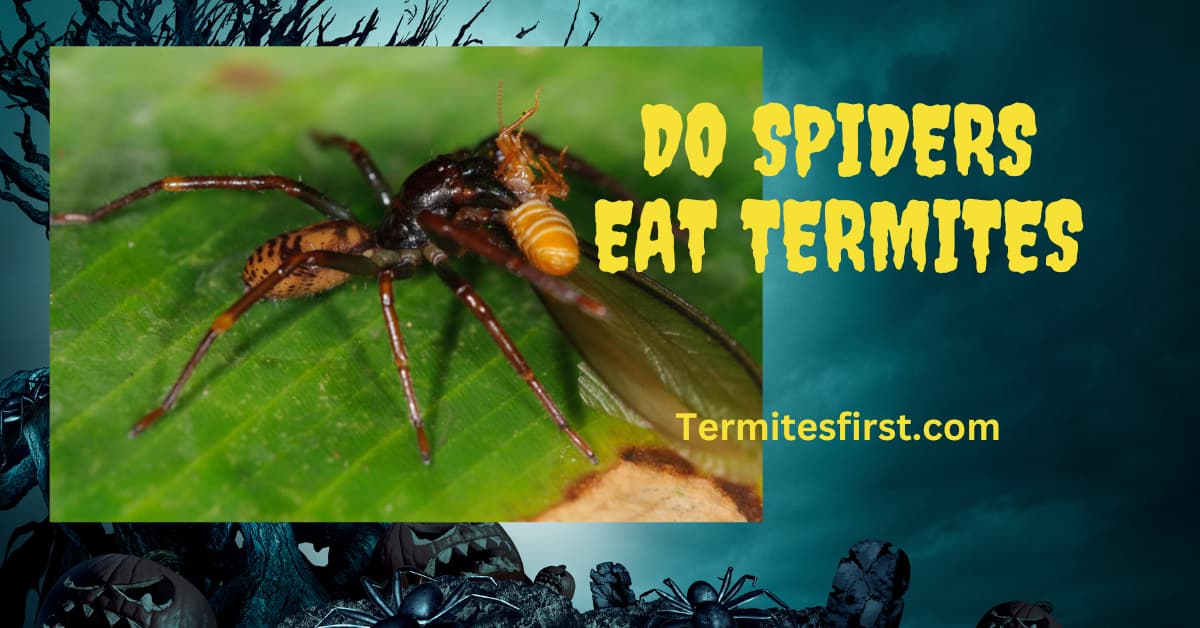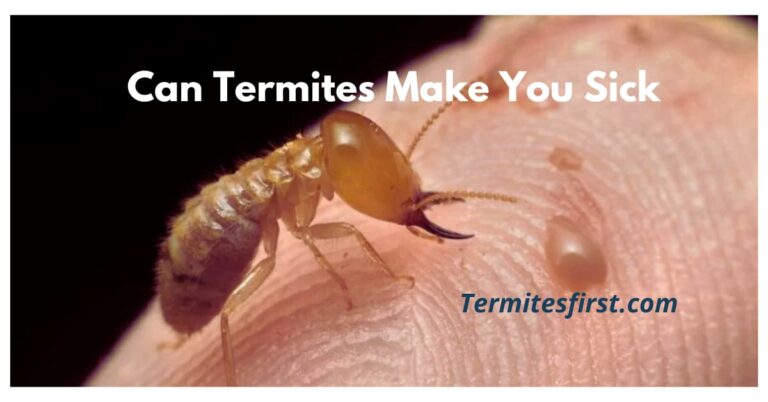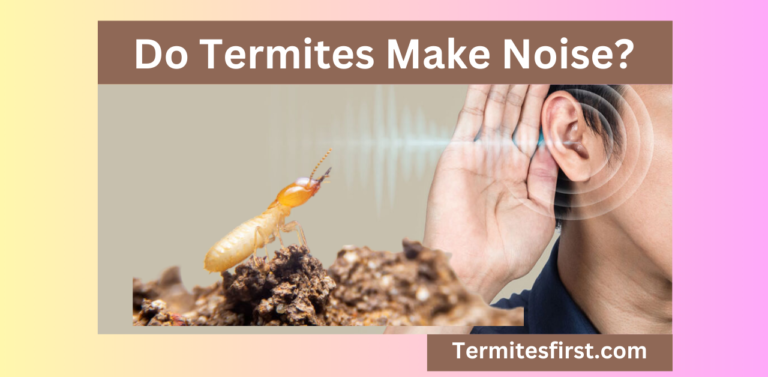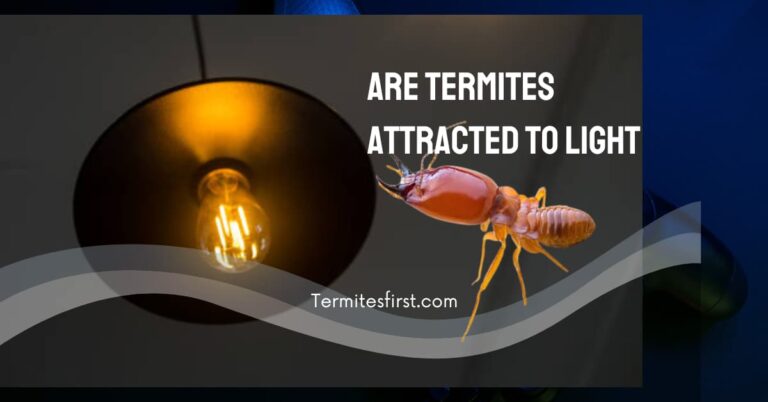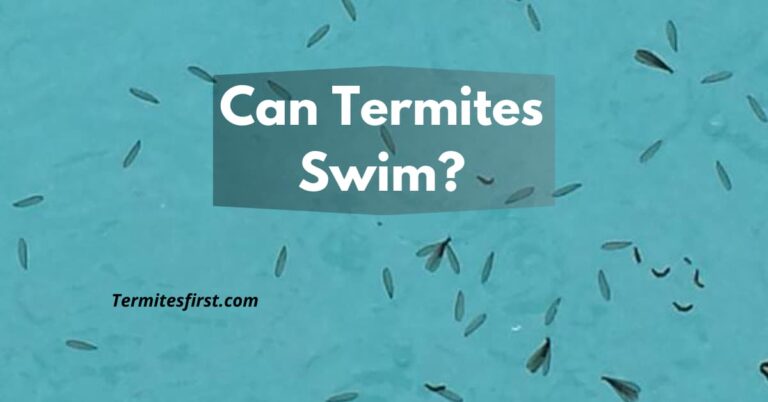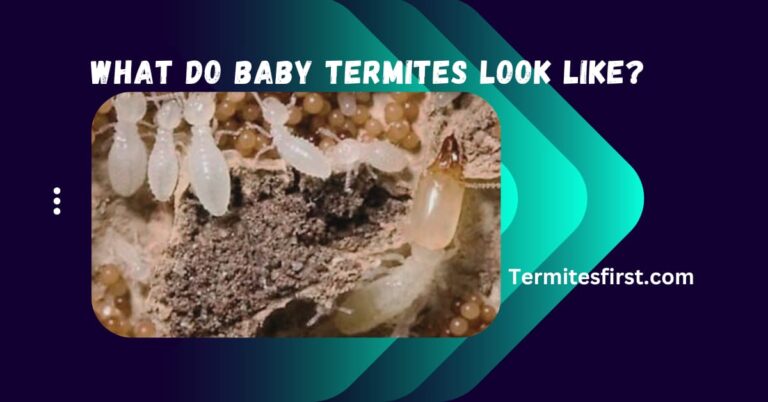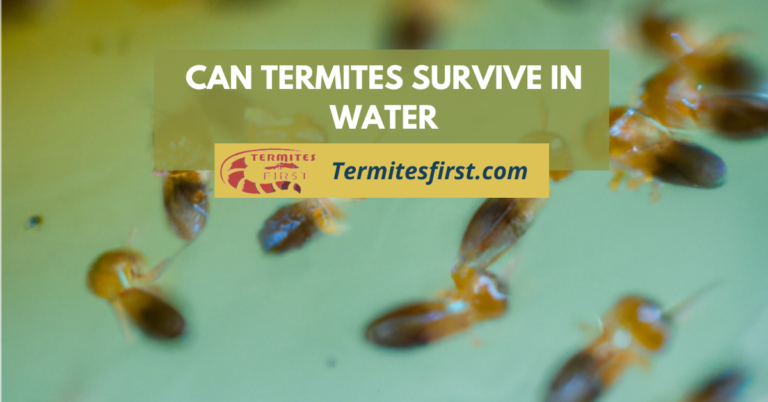Do Spiders Eat Termites? Exploring the Natural Predators of Termites
Nature’s fascinating predator-prey interactions take center stage as we delve into the intriguing question: “Do spiders eat termites“? Join us on an appealing journey through the world of spiders and termites as we uncover their unique survival strategies and surprising tales of deception and resilience.
Spiders, the crafty weavers of webs, patiently await their prey using diverse hunting techniques and venomous fangs. On the other hand, termites, the clever architects of underground societies, rely on collective intelligence and resourcefulness to thrive.
In this mesmerizing exploration, we’ll unveil the surprising relationship between spiders and termites. We explore how spiders and termites interact with each other in their food adventure and find out if spiders eat termites or if termites have clever tricks to outsmart them.
Termite Predators: Unraveling Nature’s Food Chain
Have you ever wondered what termite predators are? In their natural habitat, they prepare to be amazed by the intricate web of predator-prey relationships that govern the wild. Termites, those industrious architects of underground societies, may seem invulnerable, but they have their share of formidable foes in the animal kingdom.
Crafty arachnids like spiders lurk from the shadows, patiently awaiting an opportunity to pounce on unsuspecting termites. Their silk-spun traps and venomous fangs make them skilled predators, poised to make termites their next meal.
But that’s not all! There are other fascinating players in this food chain. Clever mammals, such as certain ant species, anteaters, and aardvarks, have developed specialized adaptations to feast on these tiny insects. They deploy tactics like sniffing out termite mounds or using their long tongues to slurp up termites easily.
In this captivating journey through the natural world, we’ll explore these predators’ vital role in regulating termite populations and maintaining ecological balance. The delicate interplay of survival and sustenance has sculpted the evolution of predators and termites, resulting in a captivating dance of life in the wild.
Join us as we venture into the heart of nature’s food chain, revealing the secrets of termite predators and their pivotal role in shaping ecosystems. From the tiniest predators to the most agile hunters, each element of this intricate web ensures the harmonious functioning of our planet’s diverse habitats. So, get ready to uncover spiders from the hidden world of termite predators!
Do Spiders Eat Termites?
When it comes to the natural predators of termites, one question that often arises is whether spiders eat termites. Spiders are renowned for being predators who can capture and eat microscopic creatures. However, regarding termites specifically, the relationship between spiders and these wood-eating pests is not as straightforward.
While some species of spiders feed on termites, it is important to note that not all consider termites a primary food source. Spiders eat a variety of things, and their choices might change based on factors including size, environment, and the accessibility of other food.
Certain spider species commonly found in environments where termites thrive may opportunistically prey upon them. These spiders may strategically position themselves near termite colonies or mud tubes used by termites for easy access to their potential prey.
It should be emphasized that spiders are only partially successful at reducing termite populations. Termites are social insects that have elaborate nest constructions and live in big colonies. They have evolved defense mechanisms against predators, including powerful jaws and soldier castes protecting the colony.
In addition to spiders, there are other natural predators of termites, such as ants, birds, reptiles (like lizards), and certain mammals (like anteaters). These predators contribute to the preservation of ecological harmony by controlling termite populations.
While some spider species eat termites as part of their diet, they alone cannot provide comprehensive control over termite infestations. Professional pest management strategies should be employed for effective termite control in homes and structures where infestations pose a threat.

Introduction to Termite Predation and Spider-Feeding Habits
Termite predation refers to termites consumed by other organisms, typically predators that feed on them. Small, sociable termites that dwell in colonies may seriously destroy timber structures. However, they are also an important food source for many other animals.
A question arises here can spiders eat termites? One group of predators that commonly feed on termites is spiders. Spiders, scorpions, and ticks are examples of the invertebrate class known as arachnids, which has joint-legged animals as members. They are renowned for their predatory tendencies and weave silken webs to catch victims. Some spider species specialize in feeding on termites, using their webs to trap and immobilize them before consuming them.
In addition to spiders, there are various other arachnids and insectivores that also feed on termites. For example, some scorpions and solitude (also known as camel spiders) are known to prey on termites.
In the case of insectivorous mammals, certain species, like anteaters and aardvarks, have specialized adaptations for feeding on termites. These adaptations include long tongues or snouts that allow them to access termite colonies and extract the insects.
Predatory behavior is common among many animal species, including those that feed on termites. It is a vital survival strategy for obtaining nutrients and energy. By preying on termites, these predators help control termite populations and play an essential role in maintaining ecological balance.
Understanding the feeding habits of spiders, arachnids, and other insectivores can provide valuable insights into the dynamics of predator-prey relationships within ecosystems. It highlights the intricate web of interactions between different species and their roles in the natural world.
The Role of Spiders in Controlling Termite Populations
In many habitats, spiders are an essential component of the termite population control process. While termites can cause significant damage to buildings and wooden structures, spiders act as natural predators and help keep their populations in check. Here’s how spiders contribute to termite control:
Predatory Behavior:
Spiders are skilled predators that feed on various insects, including termites. They use their webs or hunting techniques to capture and consume termites, preventing their numbers from reaching harmful levels.
Web-Building Spiders:
Many spider species construct intricate webs that serve as effective traps for termites and other small insects. These webs are strategically placed in areas frequented by termites, allowing spiders to intercept and feed on them.
Active Hunters:
Certain spider species search for prey, including termites. They use their excellent vision and agility to track down and capture termites, reducing their numbers in the environment.
Natural Pest Control:
By preying on termites, spiders help maintain a balance in ecosystems by controlling the population of these wood-destroying pests.
Ecological Balance:
Termites are a crucial component of ecosystems because they help recycle nutrients by decomposing dead plant matter. However, when their populations grow unchecked, they can cause significant damage. Spiders help maintain a healthy balance by regulating termite numbers without eliminating them from the ecosystem.
It’s important to note that while spiders are beneficial in controlling termite populations, they may not be able to eliminate all termites in infested areas. Professional pest management procedures could be required in situations when termite infestations are extensive or pose a hazard to structures.
Spiders naturally manage termite populations, which helps to preserve ecological equilibrium. Their predatory behavior helps minimize the impact of these wood-destroying pests and contributes to a healthier environment.
An Overview of Spider Species Known for Consuming Termites
We need to understand this, does spiders eat termites ? Spider species that are known for consuming termites belong to various families and can be found in different parts of the world. Here are a few notable examples:
Trapdoor Spiders (Family Ctenizidae):
Certain trapdoor spiders, such as the Termite-eating Trapdoor Spider (Pseudoclanis postica), are known to feed on termites. These spiders construct burrows with a hinged trapdoor and wait for termites to come within striking distance.
Jumping Spiders: Do Jumping Spiders Eat Termites?
Jumping spiders are fascinating animals renowned for their extraordinary agility and skill at hunting. While they don’t specialize in termites, they have a diverse diet and will happily consume a variety of insects, including termites.
These cunning arachnids grab their prey by leaping and using their keen vision. They actively hunt instead of creating webs, tracking and pounce on their prey, unlike other spiders. Their favorite meals include flies, mosquitoes, ants, and other spiders.
Although termites aren’t their main target, jumping spiders won’t pass up the opportunity to feast on termites when they encounter them during their hunting expeditions. Their adaptability and varied diet make them successful hunters in different habitats, be it forests or urban areas.
Crab Spiders (Family Thomisidae):
Certain species of crab spiders, such as the Termite-eating Crab Spider (Oxytate spp.), have been reported to feed on termites. These spiders typically ambush their prey by blending into their surroundings and striking when an opportunity arises.
Orb-Weaving Spiders (Family Araneidae):
While most orb-weaving spiders primarily feed on flying insects, some species have been observed consuming termites when they come in contact with their webs. Examples include the Termite-eating Orb-weaver Spider (Eriophora villa).
Wolf Spiders: Do Wolf Spiders Eat Termites?
Wolf spiders are notoriously voracious predators, and the majority of what they eat are other insects. While they are not specifically known for targeting termites as their primary food source, they are opportunistic predators and will eat termites if given a chance.
Wolf spiders are expert hunters who catch their victims using their quick reflexes and excellent vision. They don’t build webs to catch insects like other spiders; they hunt and pounce on their victims. Their diet mainly includes small insects such as flies, ants, beetles, and other spiders.
If wolf spiders come across termites while prowling, they will not hesitate to seize the opportunity and make a meal out of them. However, it’s important to note that their diet is diverse, and they will eat whatever insects they can find and capture.
While wolf spiders may occasionally eat termites, they are not considered specialized termite predators. Their generalist hunting behavior allows them to survive on a wide range of insect prey, making them versatile and effective hunters in various ecosystems.

House Spider: Do House Spiders Eat Termites?
House spiders are opportunistic predators with a varied diet, like many other spider species. While they are not specialized termite hunters, they will consume termites if given a chance.
House spiders typically build webs in and around human dwellings to catch their prey, primarily consisting of small insects such as flies, mosquitoes, ants, and other spiders. Their webs are effective traps to ensnare unsuspecting insects that venture into their territory.
When it comes to termites, house spiders may encounter them if termites happen to wander into the areas where they have built their webs. In such cases, house spiders will not hesitate to make a meal from the termites caught in their webs.
It is important to note that not all spider species consume termites as a primary food source, and their diet may vary depending on factors such as habitat and availability of other prey items. Additionally, the specific species mentioned here may vary in distribution and behavior across different regions.
The Relationship between Spiders and Termites in the Ecosystem
Spiders and termites play important roles in the ecosystem, but their relationship is often between predator and prey. As natural predators, spiders frequently feed on termites, helping control their population and maintain balance in the ecosystem. They break down dead plant matter, such as fallen leaves and wood, turning it into nutrient-rich soil. This process helps to recycle nutrients and supports the growth of new vegetation.
While termites carry out their important ecological function, they also become an essential food source for spiders. Spiders have developed various strategies to capture termites, including building intricate webs or using stealthy hunting techniques. By preying on termites, spiders help regulate their population size and prevent potential ecological imbalances if termite populations are left unchecked.
Furthermore, the presence of spiders in an ecosystem can also have indirect benefits for termites. Spiders also prey on other insects that may be harmful to termite colonies, acting as a natural form of pest control. This can help protect termite populations from other threats and promote their overall health and survival.
The ecosystem’s relationship between spiders and termites is one of predator and prey. While spiders benefit from a readily available food source, they also contribute to maintaining a healthy balance by controlling termite populations. This dynamic interaction between these two organisms plays a vital role in the overall functioning of ecosystems worldwide.
Factors Influencing Spider Consumption of Termites
Several factors can influence spider consumption of termites. Here are a few key factors:
Availability of Termites:
The abundance and accessibility of termites in the spider’s environment is crucial. In situations where termites are plentiful, spiders are more inclined to eat them.
Spider Species:
Different spider species have varying preferences for food sources. Some spider species specialize in consuming termites, while others may prefer other insects or prey items. The specific spider species present in an area can affect the consumption of termites.
Habitat and Environmental Conditions:
The habitat and environmental conditions can impact termite populations and spider foraging behavior. Factors such as temperature, humidity, vegetation cover, and soil conditions can influence the availability of termites and the spiders’ ability to capture them.
Spider Size and Capability:
The size and physical makeup of spiders can affect how well they eat termites. Larger spiders may more efficiently capture and consume termites, while smaller spiders may focus on smaller prey items.
Competition with other Predators:
Spiders may face competition from predators that feed on termites, such as ants, birds, or other insect-eating animals. The presence of these competing predators can affect the overall consumption of termites by spiders.
Will Spiders Kill Termites? Unveiling Nature’s Drama
When it comes to the question, do spiders kill termites? The answer is yes; spiders do kill termites. Spiders are skilled hunters and use various techniques to catch their prey, including termites. They may ambush termites caught in their webs or actively pursue and capture them. Once a spider catches a termite, it injects venom to immobilize and digest its prey before consuming it.
However, it’s important to note that not all spiders eat termites, as some species prefer other insects as their primary food source. Additionally, termites have developed survival strategies to protect themselves from predators, including constructing intricate underground colonies that provide shelter and safety.
Do Spiders Eat termites in Lawns in Winter?
During the winter months, the activity of both spiders and termites tends to decrease due to the colder temperatures. In many regions, termites may become less active or go into a state of dormancy during the winter, as they are cold-blooded insects and are less active in colder conditions.
Due to their cold-blooded nature, spiders may also decrease their activity in the winter. However, some spiders are more cold-tolerant than others and may still be active in milder winter climates. If termites and spiders encounter each other on the lawn during the winter, spiders may still eat termites if given the opportunity.
Spiders are opportunistic predators who consume termites or insects they can catch in their webs or through active hunting, regardless of the season. The availability of prey and the behavior of spiders and termites in a specific geographical location will play a role in determining if and how often they interact during the winter months.
Do Spiders Eat Termites’ Dry-Wood?
Spiders are predators that primarily feed on live insects, including termites. However, when it comes to dry wood, termites can be found in two different forms: dry wood termites and subterranean termites.
Drywood Termites:
Drywood termites, as their name indicates, attack dry wood and do not need soil to survive. They are known to create colonies within the wood they infest. Spiders, opportunistic predators, may consume drywood termites if they come across them in the infested wood. However, it’s worth noting that dry wood termites are often well-hidden within the wood, making them less accessible to predators like spiders.
Subterranean Termites:
Subterranean termites, on the other hand, typically live in the soil and create mud tubes to access wood above ground. They are more commonly associated with damp or moist wood. Spiders may not encounter subterranean termites directly within the wood, as they typically remain hidden in underground nests or mud tubes.
Spiders are capable of preying on dry wood and subterranean termites if they can access them. However, it’s important to recognize that termites, especially dry wood termites, can be challenging to find and access within wood structures. Additionally, the prevalence of termite-eating spiders in a specific area may depend on the local ecosystem and the abundance of both spiders and termites.
Do Spiders Eat Termites Eggs?
Spiders are crafty predators that primarily feed on live insects and small creatures. While they may occasionally consume termites, it’s less common for spiders to target termite eggs as a regular food source.
Like many insects, termites go through different life stages, including eggs. However, termite eggs are usually well-protected within their colonies, making them less accessible to spiders. Spiders typically hunt for moving prey they can catch in their webs or actively pursue.
This idea also comes here; do spiders eat termites larvae eggs? Termite eggs or larvae eggs, being stationary and guarded within the termite colony, are not the primary target for spiders.
Yet, if spiders encounter termite eggs while searching for food, they may eat them as part of their opportunistic feeding behavior.
Do spiders Eat Termites Food Items or Not?
No, spiders do not typically eat the food items of termites. Spiders are carnivorous predators, primarily feeding on live insects and other small creatures. They catch their prey using various hunting techniques, such as building webs to trap insects or actively stalking and pouncing on their victims.
Conversely, termites are herbivorous insects that primarily feed on plant-based materials, especially wood and cellulose. They obtain food from decaying wood, fallen leaves, and other plant debris. Since spiders and termites have different dietary preferences and hunting methods, spiders do not consume the food items that termites eat. Spiders are more interested in capturing live insects for their sustenance rather than consuming the plant-based food that termites rely on.
Conclusion:
In conclusion, whether spiders eat termites unravels a captivating tale of predator-prey dynamics in the natural world. While spiders are opportunistic predators with a diverse diet, termites hold a significant place in their menu when the opportunity arises. Armed with their cunning hunting techniques and remarkable adaptations, spiders actively hunt and consume various live insects, including termites. Though not specialized termite predators, they can seize the chance to feast on termites whenever they come across them during their foraging expeditions. Termites, in turn, are ingenious architects of their underground realms, primarily feeding on plant-based materials like wood and cellulose. Their ability to decompose helps recycle nutrients and keep their ecosystems’ natural equilibrium. By delving into the interactions between spiders and termites, we gain a deeper appreciation for the intricate web of life and the diverse strategies creatures adopt in their struggle for survival. The fascinating interplay between predator and prey in nature highlights the delicate balance required to support life on our planet.
FAQ’s:
Termites face many natural enemies in the wild, but ants are one of their greatest foes. Ants, especially army ants and driver ants, are highly skilled predators that attack termite colonies in large groups. They have strong jaws and release chemicals that disrupt termite defenses. Other predators like birds, reptiles, and mammals also eat termites.
Termites eat plant-based things like wood and leaves. They have special abilities to digest cellulose found in plants. In nature, termites help recycle nutrients by breaking down dead plant material in the soil. However, when they infest wooden structures, they become pests.
In some cultures or superstitions, termites may be associated with bad luck or misfortune due to their ability to cause damage to wooden structures. Their presence can lead to costly repairs and inconvenience for homeowners, which could be seen as unlucky. However, termites are essential decomposers in the environment, helping to recycle nutrients and decompose dead plant matter. This is seen from a natural ecological perspective. In this sense, they are not “unlucky” but rather an essential part of the balance in nature.
Termites do not harm humans directly, as they do not bite or transmit diseases. However, they are pests that need to be avoided by taking preventative measures and being identified early in order to avoid destruction to buildings and timber structures.
Some termites can fly, known as “swarmers” or “alates.” These winged termites are reproductive adults that emerge from mature colonies during specific times of the year for mating. After finding mates, they shed their wings and establish new colonies. Not all termite species have winged individuals, and the presence of flying termites depends on the species and local conditions.

